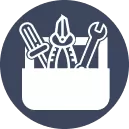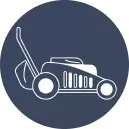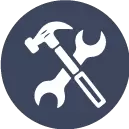A landscaper with good equipment can make any outdoor space look like a masterwork. This category encompasses everything for landscaping work large and small, from power tools to trucks.
It includes everything from hand tools for intricate planting to heavy machinery for earthmoving. It even has safety gear and maintenance items to keep people and tools in good shape. Collectively, these all work to help landscapers plan, create and maintain gardens, lawns and hardscaping with effortless and safe tools.
Hand Tools
Hand tools provide that level of detail for planting, pruning and soil work that landscapers need. They're light and convenient to take along and can fit in cramped spaces.
- Shovels, Spades, and Trowels: These are tools that dig holes and move soil around as well as mix fertilizers. Landscapers prefer solid steel heads and extra-long handles for more reach and strength.
- Garden Forks and Rakes: Garden forks turn over hard soil and remove rocks. Rack beds and remove leaves, trash, and debris. Both are quick and easy for preparing planting areas.
- Pruning Shears, Loppers, and Hedge Shears: These cutting tools allow people to trim branches, shape shrubs and keep hedges tidy. Rust-resistant, sharp blades make clean cuts that heal more quickly.
- Specialty Hand Tools: Hand tools such as post-hole diggers, bulb planters and hand weeders can streamline redundant tasks. They make holes evenly or pull weeds without damaging the roots of neighbouring plants.
Powered Tools
Power tools allow landscapers to cover more ground in less time. They save time and produce reliable results.
- Lawn Mowers: From plain push mowers to zero-turn-riding units, these devices help keep lawns flat and trimmed. Landscapers choose models according to the size of yards and the type of terrain.
- String Trimmers and Edgers: For clear lines and corners along driveways, flower beds and fences. They contribute to the polished, professional look of any landscape.
- Leaf Blowers and Vacuums: Lightweight blowers are easy to handle, but still very powerful to blow leaves, cuttings, and bushes in a snap. A few offer the option of converting to vacuums and mulchers for easy cleanups.
- Chainsaws and Pole Saws: Chainsaws are commonly used for cutting wide branches or small trees. Pole saws can reach tall limbs without a ladder, making tree work safer and faster.
- Electric vs. Gas Models: Cordless electric tools run quietly and without emissions. Gas engines deliver greater run times and power for larger jobs. Landscapers select what they need for each job.
Heavy Equipment
Heavy machinery is often required for big landscaping projects. These machines excavate soil, dig trenches, and move land with speed.
- Excavators and Backhoe Loaders: Excavators and backhoe loaders work to dig the foundation of patios, remove tree stumps and trench for irrigation. They deal with the most difficult digging tasks.
- Skid Steer and Compact Track Loaders: With small footprints and a variety of attachments, these loaders can work in tight spaces. They use buckets, forks or augers to grade, haul and dig.
- Wheel Loaders: Wheel loaders, also known as front end loaders, carry large loads of soil, gravel or mulch at once. They accelerate the movement of materials on large projects.
- Attachments for Versatility: With a good attachment like an auger to dig holes, a trencher to lay pipes or a plow for winter work, one machine can do a lot of jobs.
Material Handling Equipment
Transporting heavy or oversized materials safely speeds projects along and reduces fatigue.
- Wheelbarrows and Garden Carts: Landscapers load soil, stones, or plants into wheelbarrows for short hauls. Carts with larger wheels can carry heavier loads over rough ground.
- Utility and Dump Trailers: Hooked to trucks or ATVs, these trailers haul tools, plants, or debris between storage and work sites.
- Hand Trucks and Dollies: Upright hand trucks carry potted trees or bags of soil. Dollies with flat platforms move planters, pavers, or equipment easily.
Irrigation and Soil Preparation
The flowers grow best when the plants are healthy with good soil and proper watering. These aids contribute to excellent root development and bed preparation.
- Broadcast Spreaders: These push type or tow-behind spreaders deliver seed, fertilizer or herbicide evenly over large areas.
- Sprayers: These are for liquid treatments like fertilizers, pesticides, or weed killers, backpack or wheeled sprayers, which ensure even coverage.
- Aerators and Tillers: Aerators extract small plugs of soil from lawns to allow air, water and nutrients to reach roots. Tillers churn up hard soil, blending in compost or fertilizer.
- Irrigation Systems: Water plants with hoses, drip tubing and sprinkler heads. Timers and adjustable nozzles help distribute the right amount of moisture to each zone.
Safety Gear
Landscapers depend on protective gear to keep them safe from sharp blades, noise and any flying debris. Safety gear is a must on every job.
- Eye and Ear Protection: Safety glasses and goggles shield against wood chips and dust. The earplugs or ear protectors protect the ears from damage caused by loud tools.
- Gloves, Boots, and Clothing: Cut proof gloves protect hands from brambles and thorns. Steel-toed boots safeguard feet in rough terrain or construction zones. High-visibility vests keep workers visible.
- Specialty PPE: Chainsaw chaps protect legs from injury. Hard hats protect against falling limbs. Respirators help to block harmful sprays and dust from entering the lungs.
Attachments and Accessories
Attachments make one machine many, reducing the cost of equipment and the space it takes up.
- Augers: Mounted on skid steers or mini-excavators, augers drill uniform holes for posts, trees, or fence foundations.
- Pallet Forks and Bale Spears: These forks carry pavers on a pallet or rolls of sod. A bale spear looks after round straw or hay bales for erosion management.
- Trenchers: Trenchers cut accurate trenches every time for irrigation lines or electrical wires, and save time compared to manual digging.
- Seasonal Blades and Sweepers: Attach plow and snow-blower blades to clear snow in winter. Rotary brush sweepers are used to clean drives and paths during the season.
Maintenance and Storage
By maintaining tools and storing them properly, they will be ready to complete the next job and have a longer working life.
- Landscapers remove dirt and debris after each use. They look for damage, loose parts or dull blades.
- Blades of shears, mower decks and saws are always sharp and make safe cuts. Engines require fresh oil, new filters and spark plug inspections.
- Dry sheds or chests keep tools from the weather. Pegboards, racks and labeled bins help ensure one can find the right tool at a glance.
Summary
Landscapers are able to address every aspect of outdoor work thanks to the proper combination of hand tools, power equipment, machinery and safety gear. Whether planting, pruning, grading or clearing, the using these tools makes it possible to create beautiful, healthy landscapes, and safely and productively get through every task.








